Light front bomber and torpedo bomber Tu-14 (Part of 2) Construction and operation
The second pressurized cabin, having a hatch in the lower part, served to house radio and electrical equipment. Under the hatch mounted brake flap. The container with the boat LAS-3М - along the side of the aircraft to the right, the container of the brake parachute and the hatch for it - from below.
Access to the cockpit of the gunner-radio operator was carried out through the lower hatch, he also served for the ejection. When an emergency landing on the fuselage in the left side of the cockpit shooter provided emergency hatch. To protect the tail of the two guns served HP-23.
Trapezoidal wing - caisson design, two-spar. It consisted of two detachable parts and a center section. The wing housed the 14 tested soft fuel tanks. The wing had four-section landing strips. Their cleaning and release were made using the hydraulic system. A trimmer was installed on the right aileron.
After the third engine was removed, the base of the keel grew into forkline. For the uninitiated, this caused considerable surprise, given its functional uselessness. In addition, he increased the side surface of the fuselage, complicated takeoff with side wind and gave the aircraft excessive travel stability in flight.
The handlebars were supplied with aerodynamic and weight compensation and trimmers. Socks stabilizer and keel equipped with electric de-icing systems. When the system was turned on, the keel was heated constantly and the console alternately. Since tail heating required about 50 percent of the power of on-board power sources, it was turned on only when two generators were in operation.
Chassis - with retractable safety tail support and front wheel. The main and the front rack was removed back. The main pillars of the latter having brake wheels unfolded at 90 degrees.
To reduce the mileage used band brake parachute. To reduce the take-off distance, four powder launch accelerators PSR-1500-15, mounted under the center section, were installed. They worked non-simultaneously: first, the internal pair of accelerators worked, and after a specified interval - the external one. Their launch was made by the pilot, reset - by the navigator, in case of emergency - by the pilot.
Aircraft control - tough, single. Very originally, the corners of the transition to the non-hermetic compartments of the sealed. Control trimmers - electromechanical, remote. In the control of the aileron and rudders, the autopilot steering autos AP-5 are included.
The fuel was placed in 24-x protected soft tanks, with a total capacity of 10300 liters. The fuel system differed significantly from its predecessors. Probably, one should proceed from the fact that the aircraft had a thin wing, and the float level meters installed in tanks of conventional design did not fit. In connection with this, capacitive sensors were used. In order not to distract the crew on the procedure for controlling the production of fuel and not to spend time on pumping to maintain centering, the aircraft was provided with automatic generation of kerosene tanks from each group. This was achieved through the use of special fuel level sensors. The process was controlled using EBT-156-81 non-floating electric fuel meter.
The main feature of the hydraulic system was the serial connection of the working consoles (chassis, bomb bay, landing plates and brake flap) with a source of pressure. This constructive solution concealed a lot of potential troubles, which soon became apparent. If the brake flaps did not return after the take-off of the console, the pump seals failed and the hydraulic mixture was thrown out. I had to use an emergency hydraulic accumulator, rechargeable, if necessary, with a hand pump.
For example, a premature shift to the neutral position of the chassis could result in the front strut folding on the run. In this regard, it was impossible to judge the release of the chassis due to the ignition of the lights of the released position (green indicator) - it was necessary to control their locking by pressure. A certain hierarchy was observed in the system: if the pilot did not return the chassis console to the neutral position, the release of the brake flaps was not excluded.
The air system serviced the emergency release of the chassis, air brake, shields, emergency reset of the pilot's lantern, fuel drain, sealing the cockpit, closing and opening the navigator's hatch in flight and on the ground.
Radio equipment included command RSIU-3 and coherent RSB-5 radio stations, blind landing equipment, automatic radio compass ARK-5, radio altimeters of small and large heights РВ-2 and РВ-10, interrogator of an autonomous identification system ("Magnei-M"), device of the device bombing and navigation, aircraft intercom. In the compartment with the boat LAS-3M (LAS-5) the emergency radio ABRA-45 was located.
The aircraft could have night and day cameras equipped with lenses with different focal lengths; the PHARM-2 prefix was used to photograph the screen of the radar station.
The pilot, in an emergency, catapulted upwards, while his trajectory passed very close to the keel, the radio operator and the navigator went down. To rescue crews, band parachutes were used on the first aircraft, parachute oxygen instruments and the MLAS-1 submarine were also placed in their satchel.
Bombing equipment for this class of aircraft was typical. It consisted of: synchronous optical sight bombing OPB-6ср associated with PSBN-M, providing bombing of radio-visible targets, torpedo, girder and cluster holders. On the plane, besides the sights, there was a navigation target for measuring the angle of demolition of the AB-52. The scope of the PTN-50 was intended for low torpedoing.
For firing a pair of fixed nasal guns (200 cartridges) used collimator sight PKI-1. Two more guns were installed on the aft mobile unit KDU-81 equipped with an ASP-3P sight. Ammunition for each barrel - 450 cartridges.
For the flight crews that previously operated Pe-2 and Il-2 aircraft, the Tu-14 equipment was completely new (with the exception of crews flying American-made airplanes).
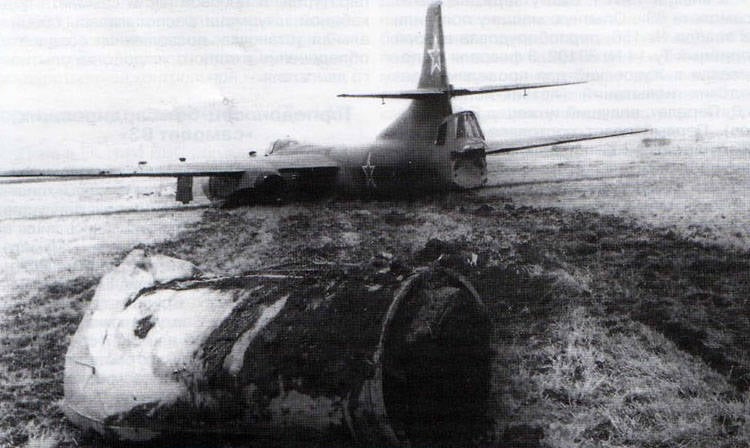
In April 1951, by order of the Minister of the Navy, the dates for the rearmament of parts of the mine-torpedo were established aviation on IL-28 and Tu-14. For this reason, control and export flights before pilots were allowed to fly on the Tu-14 were carried out on the Il-28U.
Knowing that the technical education system of the flight crew, which studied in detail how one or the other spool or valve works, was ill-conceived, it is easy to guess that the pilots had to master two completely different planes, including instructions for combat use and piloting techniques. Despite this, in all documents of the naval aviation headquarters fleet of that period there was constantly an indication of the need for "good knowledge of the design of the aircraft as well as all units to obtain automated skills in working with its units ..."
And two planes, albeit with some similar parameters, required sensible, not automated actions, which was caused by a significant difference in cabin equipment. The consoles, cranes and control levers of the same purpose were located in different places and the operations for actuating the actuator were significantly different.
Despite the subjective and objective difficulties, the mine-torpedo aviation pilots retrained willingly to jet aircraft. Pilots were confident that the reliability of jet engines compared to piston engines is higher, they produce less noise and have many other advantages.
After sixty control and export flights in a circle and in the zone, the pilots got access to independent flights on an Il-28 aircraft under simple conditions and were considered prepared for the transition to Tu-14. This was preceded by simulations in the cockpit of a Tu-14 bomber.
The originality of the procedure for the admission of pilots to the flight on the Tu-14 did not differ. The instructor with the student performed two or three demonstrative flights. In this case, the pilot was located either behind the instructor (on the gyro of the longitudinal-lateral stabilization of the autopilot) or next to it. During the familiarization flight to the zone, the instructor demonstrated the performance of the flight on the 1 th throttled engine, combat turns, shallow and deep turns, switching on and use of the autopilot. Then several flights were made in a “box” with a go-around.
The plane on taxiing was stable, but it required increased engine speed, in comparison with the lighter IL-28U, while the brakes quickly overheated, and it was necessary to use them with caution.
Taking off on a Tu-14 with a normal mass compared to the IL-28 was easier. Due to the larger chassis base, the run-up was more stable, the front wheel lift was easier controlled than on the IL-28, which tended to progressively lift the wheel.
Tu-14 on the run-up, even with a normal mass, slowly picked up speed, so it seemed that the engines had less thrust. The nerves of some pilots could not stand and they "undermined" the car at a speed lower than 180 km / h. For this reason, in June of 1953, a Tu-14 crash occurred, piloted by Senior Lieutenant Yurchikov, pilot of the 46 th torpedo air regiment of the Pacific Fleet aviation. The flight was made from the Knevichi airfield, the runway length of which was 2000 m, while the estimated run-up - 1900 m.
The airplanes that took off before this came off 100 meters before the edge of the strip, which created the prerequisite for the incident. In the end, it happened. The plane which has come off at low speed landed on stubs uprooted behind a strip. The nose section collapsed, and Senior Lieutenant Melamoud, the navigator of the aircraft, died. When asked about the recommended lift of the front wheel, the CB replied - see 51. But how to check it?
In contrast to the IL-28, the aircraft after separation needed to be maintained. Many pilots remained convinced that due to the irrational design of the air intakes, the Tu-14 engines had less thrust compared to the IL-28. It was not possible to verify, but such a statement of the foundation is not deprived, because the design bureau on one of the experimental machines tried to install air intakes of a larger section.
On the very first flights on jet planes, the pilots were convinced that in most cases the engines work reliably, there is much less noise in the cockpit, the connection using the VHF radio station with the flight director is stable, the crew members also began to understand each other.
At high altitude, piloting the aircraft was not particularly difficult, but required pilots to perform the evolution of more coordinated and precise movements of the rudders. The aircraft at altitudes above 9 km is inert, slowly responding to the deflection of the rudder and ailerons. Compared with piston airplanes, a place in the ranks was more difficult to maintain; the air brake, especially at high altitudes, was not effective enough. At medium altitudes, the autopilot AP-5 worked quite steadily, but did not rule out any additional adjustments in flight.
When the crews, after acquiring the first skills, began to use in combat, it turned out that there were difficulties with side-laying with the open doors of bomb-bombs. After that, they began to open immediately before the bombing (dumping torpedoes).
The main type of combat use was considered bombing with an optical sight and high-altitude torpedoing, mainly torpedoes of PAT-52, which did not differ from bombing. Crews low torpedoes almost never used. After acquiring the skills of using a telescopic sight, the crew began to master bombing on radio-visible targets, using the PFM-M as a reticle. This, due to the complexity of operating the equipment in flight and its imperfections, was a rather difficult task. This miracle of domestic technology consisted of 26 controls, excluding installed on OPB-6сr, used in this case as a crucial device.
The landing of the Tu-14 was not difficult, the plane, unlike the IL-28U, after leveling off and switching to the idle mode of the engines, quickly lost speed. Incomplete release before landing wing flaps threatened quite unpleasant consequences, the plane sank abruptly and when landing the movement of the steering wheel had to be very energetic. Otherwise, the car landed on the 3 wheels or ahead of the front support, the progressive “goats” started.
Captain Dubin in December 1951 of the year, driving the Tu-14 to the North, while landing in a similar situation, broke the car. The front strut wheel collapsed due to a strong blow, the navigator's cabin lining deformed and he was injured. Pilot reproached that he later opened the braking parachute. As it turned out later, the recommendation is more than doubtful.
In February 1952, the aircraft of senior lieutenant Svichkarev crashed. He landed with undershot guards. As in the first case, the plane, after a rough landing, landed first on the 1-1,5 meter, and then on the 3 meter. The pilot released a braking parachute. Under these conditions, the worst solution is hard to come up with, the plane went sharply on the nose and the fuselage broke into two parts from the blow.
The pilots in both cases tried to use a braking parachute in a situation for which it was not intended. This is due to various delays in filling the dome and the ability to predict when this will happen is not.
It should be noted that on the Tu-14, tires and wheelchambers often failed due to improper use of the brakes. Brake parachute used quite rarely, sparing those. composition due to the complexity of its placement in the container, and its use at speeds less than 100 km / h did not give effect.
During the operation of the aircraft Tu-14 troubles, including those associated with crew errors, were few. So, in July of 1953, a Tu-14 crash occurred, piloted by Senior Lieutenant Zhitkov, the pilot of the 5 th mine-torpedo air division of the SF Air Force. Leading captain Ramensky, after entering the clouds, gave the left slave a command to increase the interval and continued to gain altitude at an unacceptably low speed (about 330 km / h). The group with the left roll entered the clouds. Probably, the slave lost orientation, the plane went into a disorderly fall, collapsing in the air. Probably, there was a power failure in the artificial horizon, which had no backup sources.
In September, 1953, in the same division, a plane crash that was piloted by Senior Lieutenant Rezinkin took place. Tu-14 at an altitude of 300-400 meters encountered an obstacle.
In the summer of next year, Captain P. Byshev, the fighter pilot of the 535 th Fighter Aviation Regiment of the 32 Fighter Air Division, did not understand the situation, reported on the detection of the Canberra aircraft and apparently did not consider any identification marks. From his leaders, he received the order to shoot down the "intruder." As a result, the Tu-14 46 th mine-torpedo air regiment of the Pacific Fleet was shot down. The whole crew died.
The Pacific Fleet Air Command, in order to avoid a repetition of similar incidents, made a belated decision to display the Tu-14 in flight over the airfields of fighter aircraft. The pilot who shot down the Tu-14 soon died, unable to cope with the piloting of the aircraft in adverse weather conditions. Perhaps it was a retribution.
The Tu-14 was not operated for a long time - by 1957, they were put into reserve, in other words, they were decommissioned, and parts were re-equipped with IL-28, although it was inferior in some characteristics to Tu-14.
The design bureau attempted to diversify the Tu-14 family by expanding their scope. For example, an attempt was made to create a photo scout. On the second production aircraft, additional fuel tanks were installed in the bomb compartments, as well as a set of cameras for various purposes and types, including a rocking installation. The photographer was prepared for serial production, but the release of the IL-28P was already in progress.
A.N. At the beginning of 1953, Tupolev proposed to build a torpedo bomber with two VK-14 (5) and swept wings on the basis of the Tu-7 bomber-torpedo bomber. The designer promised that the plane would reach speeds of 1050-1100 kilometers per hour. Acting by a proven method, Tupolev sought a decision to launch in parallel with the construction of a prototype aircraft in the series without preliminary factory tests. However, MV Khrunichev stopped this attempt. The answer, apparently, turned out to be unexpected, but quite definite: “Attempts to launch experienced aircraft into the series, without passing state tests, showed that a large number of flaws and defects identified later became the cause of numerous alterations in the series, which upsets the work of production plants and delays terms of development of a prototype aircraft. "
As a result of the acceleration of the introduction did not occur. On the example of the Tu-14, it is clear that the rework required a lot of attention and time, and the plane was behind the times. Tu-14 had a short life, but despite this he left a good memory of himself.
Aircraft performance characteristics:
Modification - Tu-14T;
Wingspan - 21,67 m;
Length - 21,95 m;
Height - 5,69 m;
Wing area - 67,36 m2;
Empty weight - 14930 kg;
Normal take-off weight - 20930 kg;
Maximum take-off weight - 25930 kg;
The mass of fuel - 4365 kg;
Engine type - 2 turbojet engine VK-1;
Traction - 2x2700 kgf;
Maximum speed at height - 845 km / h;
Maximum speed at the ground - 800 km / h;
Practical range - 2930 km;
Combat radius of action - 1200 km;
Practical ceiling - 11300 m;
Crew - 3 person;
Armament:
- 4 x HP-23 - two guns motionless in the nose of the fuselage under the front cockpit (2x85 shells) and twin guns in the aft installation of KDU-81 (2x350 shells);
Bomb load - from 1000 to 3000 kg.

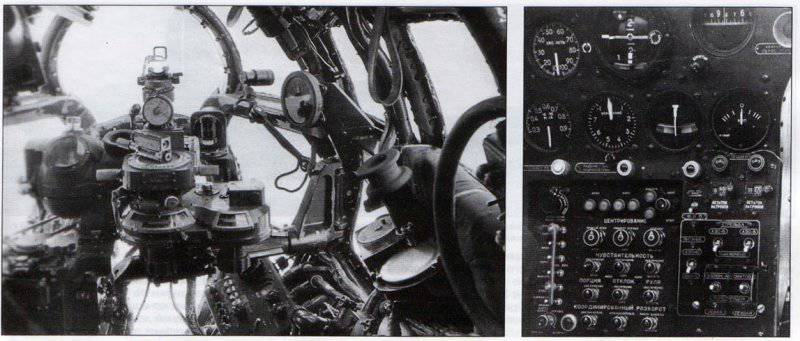





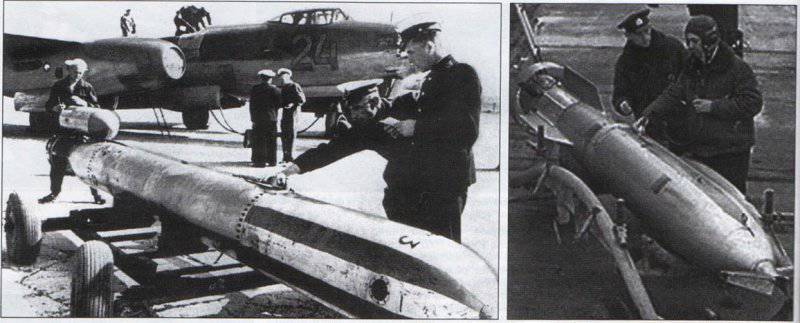
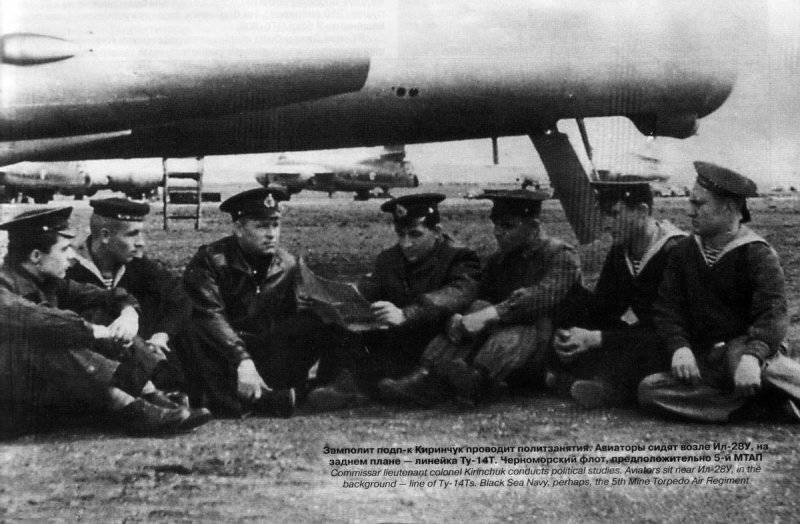
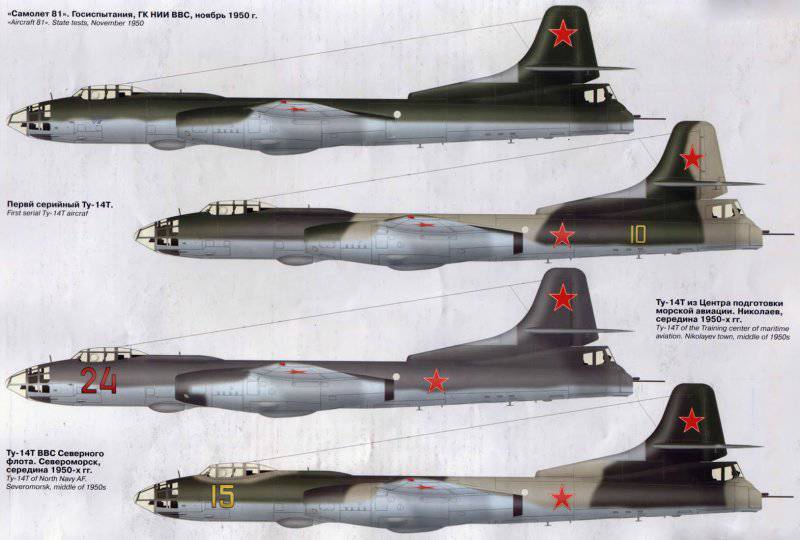
Information